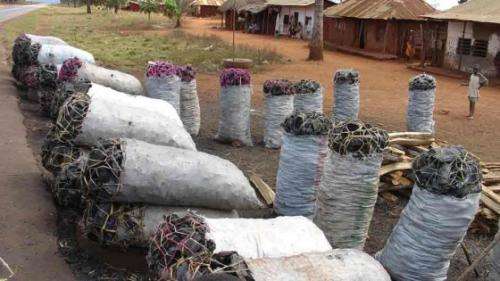Scientists calculate the true cost of saving rainforest, improving food security

(PhysOrg.com) -- New research shows that international plans to pay developing countries to reduce tropical forest destruction may increase rural poverty because critical income streams to rural people have been ignored.
The team of African, US and UK scientists and economists calculated the costs to local people of conserving forests across half a million square kilometres of Tanzania, an area of rapid forest conversion coupled with intense poverty and food insecurity. The study shows that charcoal production – usually ignored in estimates of the cost of slowing deforestation – makes up one-third of the profit of converting Tanzanian forests and woodlands to agriculture.
The research suggests that slowing deforestation will be considerably more costly than reported in the Stern Review, an influential document which discusses the threat of climate change to the world economy. The study’s findings are published today in Nature Climate Change.
Lead author Dr. Brendan Fisher of Princeton University said: “For an international payment system like the United Nations’ new REDD+ Scheme – Reducing Emissions from Deforestation and forest Degradation – it must, at the very least, cover the costs of forest conservation to those that rely on tropical forests for their livelihoods.
“However, the REDD+ scheme has a potentially more intractable problem. Even if the full costs are paid, where will the area’s increasing food and fuel demand be met if agriculture stops expanding? Payments may mean that deforestation could merely move to areas of tropical countries outside of the REDD+ program. This would be a serious deficiency as REDD+ is designed to reduce carbon dioxide emissions to tackle climate change.”
The researchers put forward a novel approach, called Smart-REDD, to tackle these problems by first calculating the increase in crop yields on existing land and the increase in fuel-efficiency of charcoal cook-stoves that are needed to meet the demand currently met by forest destruction. Then the team computed the cost of implementing a scheme to boost crop yields, distribute high efficiency cook-stoves and monitor and protect the forests.
The cost of implementation, at US$6.50 per tonne of carbon dioxide saved, is larger than the cost to merely compensate forest users, which is US$3.90. But the sums are still considerably less than the current market price of carbon (currently around US$24 per tonne carbon dioxide in the European Trading Scheme). The team’s research suggests that even a doubling of agricultural yields is possible at US$12 per tonne of carbon dioxide.
Cambridge University’s Professor Andrew Balmford, a co-author, said: “From our calculations it may be possible to link large increases in food production and food security with carbon conservation in extraordinarily biodiverse forests, and all at a pretty low cost. With governments of richer, polluting countries – like the UK – gearing up to make REDD+ payments to slow deforestation in poorer ones, we hope that results like ours can help them target their investments in ways that are both practical and cost-effective.”
Co-author Professor Pantaleo Munishi of Tanzania’s Sokoine University of Agriculture, added: “In Tanzania we are faced with many interrelated problems, so solutions like this – with potential to work across problems – are the ones that have the greatest chance to make a difference. This is especially important because of existing food insecurity and the strong link between agricultural expansion and forest conversion.”
Dr. Simon Lewis, a forest carbon expert at the University of Leeds and co-author on the study said: “The novel angle of this research was linking an understanding of the true costs of forest conservation with practical interventions which could actually decrease forest conversion in the first place. Of course, research in other areas is needed as the drivers of deforestation and interventions may be different compared to tropical Africa. But it is exciting that Smart-REDD practical interventions that meet the demand for tropically-grown commodities could make REDD+ a much-needed success story in terms of climate mitigation, biodiversity conservation and human development.”
Provided by University of Cambridge












